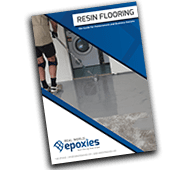Home › Advice › Know How › Knowhow
All You Need to Know About Flake Flooring
Before you specify a flake floor, there are certain things you need to understand.
This post provides a series of videos that explain the most important aspects from
A-Z...or as I put it, from introduction right through to the "the good, the bad and the ugly".
Video Transcription:
Hi, and welcome to the next series in resin flooring.
This series is called flake flooring, or seamless floors, as some people also refer to them.
Seamless flooring or flake flooring is a thin film resin broadcast system, which means, in the lay terms, that you are brushing and rolling on a resin, and while the resin is wet, you will broadcast a paint flake or paint chip into it and allow it to cure.
The next day, you will either sand or scrape, or both, the excess flake off and apply your clear (PU) topcoat, or topcoats, depending on what you require.
Now, because it has a paint flake in the system itself, it's naturally textured, it has some ripple effect. Now, this is good for forgiveness as far as looking at the floor and not having to have a full high gloss, super shiny, dead flat, slippery looking finish.
But it also means that you have some hiding power, so if your concrete slab isn't the best, then you can get away with minimal crack repairs and divot repairs and so forth, and the ripple effect of the flake does help to hide some of those imperfections in your concrete slab.
This type of resin flooring weathers like other resin floors in the sense that if it's exposed to full UV, it will discolor over time. And this is prominent, or shows more if you have a sharp line. And an example of sharp line might be a pot plant sitting there that you then decide to move after 12 months, you could potentially see where the pot plant was compared to the surrounding area.
The way to deal with that is it really comes down to the choice of your topcoats.
The higher quality, what's called aliphatic polyurethane, or polyaspartic top coats, is the way to provide the best weathering resistance over time.
And you can also request, or seek, for additional UV absorbers. These are additives that go into the topcoats to go into your particular flooring system to give you an extended or prolonged period of time.
The next installment we'll go through and start to talk about some of the good, bad and ugly part of it, what warranties and lifetimes and things to expect, so stay tuned.
I'm Jack Josephsen, and this is brought to you by Real World Epoxies.
-
Products - Use quality resins and flake that are designed to get the best possible finish:
- Ezypoxy Rollcoat - Tintable Epoxy Rollcoat
- Ezypoly - One-pack, Moisture-cured Polyurethane
- Resin Vinyl Flake - Coloured Flake Chips
- Resin Granite Flake - Coloured Flake Chips
-
Systems - Specify specialist flake flooring systems with proven performance:
- Resin Vinyl - Decorative Flake Flooring System
- Resin Granite - Decorative Flake Flooring System
-
Learning - Learn more about flake flooring, and much more, with our online courses:
- Epoxy Flooring How To Videos
- Epoxy Flooring Short Courses
- Garage Granite Installation Course
- Bronze Card Course
- Silver Card Course
-
Ask a question - If you have any questions you'd like to ask us about this topic, hit the support button below:
_800x271a.png)
